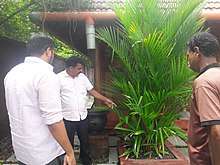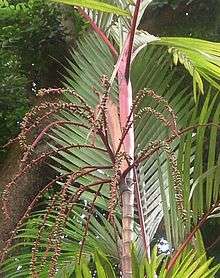Cyrtostachys renda
Cyrtostachys renda, also known by the common names red sealing wax palm and lipstick palm, is a palm that is native to Thailand, Malaysia, Sumatra and Borneo in Indonesia.[2] It is the only species of the genus Cyrtostachys that can be found to the west of the Wallace Line, the faunal boundary separating the ecozones of Asia and Wallacea.[10] Cyrtostachys renda's name is derived from several words: the Greek prefix κυρτό- (cyrto-) meaning bent or curved, the Greek word σταχυς (stachys) meaning "an ear of grain",[11] and "renda" a Malayan Aboriginal word for palm,[12] which happens to be homonymous to the Portuguese word "renda," meaning income.
| Cyrtostachys renda | |
|---|---|
| Cyrtostachys renda in the Central University of Venezuela Botanical Garden | |
| Scientific classification | |
| Kingdom: | Plantae |
| Clade: | Tracheophytes |
| Clade: | Angiosperms |
| Clade: | Monocots |
| Clade: | Commelinids |
| Order: | Arecales |
| Family: | Arecaceae |
| Genus: | Cyrtostachys |
| Species: | C. renda |
| Binomial name | |
| Cyrtostachys renda | |
| Synonyms[2] | |
| |

Because of its bright red crownshafts and leaf sheaths, Cyrtostachys renda has become a popular ornamental plant exported to many tropical regions around the world.[13] Although it is not the source of sealing wax, the red sealing wax palm got its name because its crownshafts and leaf sheaths have the same color as the wax used to seal letters close and later (from about the 16th century) envelopes.[14]
Description
Also known as the red palm, rajah palm, and Malay: pinang rajah,[15] Cyrtostachys renda is a slender multi-stemmed, slow-growing, clustering palm tree.[16] It can grow to 16 metres (52 feet) tall.[17] It has a scarlet to bright red colored crownshaft and leaf sheath, making it distinct from all other species of Arecaceae.[18]
The plant's stipe grows up to 10 centimetres (3.9 inches) in diameter. Its petioles grow up to 15 centimetres (5.9 inches) long and have pinnate leaves have about 50 pairs of pinnae. The plant's fruits are ovoid, 1.4 centimetres (0.55 inches) in diameter, green, turning to a dark bluish-black when ripe.[13][18]

Cultivation and uses
The lipstick palm is generally grown for its brightly colored and unusual foliage and it is considered as a plant in high demand for gardening and a landscaping projects.[16] Because of difficulties propagating them and their striking color, the palm has been offered for sale at prices as high as $1000 USD to collectors and gardeners.[21] It also has some limited traditional uses such as for flooring materials, roof thatching, and for making darts in Pahang and elsewhere in Malaysia.[10][13] Some rural communities in Sumatra harvest the plant for palm hearts.[17][22]
Propagation can occur with fresh seeds, although they are slow to germinate, or through dividing out suckers.[23] In the wild, the most suitable environment for growth occurs in areas of Southeast Asian lowland peat swamp forests with the following characteristics: good soil drainage, high sand content in the soil, a thin peat layer in the soil, a low carbon to nitrogen ratio (C/N) in the soil, low acid, and nutrient levels in the soil and water but relatively high organic substance levels.[10] The palm grows well in full sun or shade but needs humid conditions and well-draining soil. However, it also tolerates flooding and can grow in standing water as its native habitat is peat swamp forests.[18] It will not tolerate cold temperatures or periods of drought.[16]
Conservation status
Cyrtostachys renda was listed as "Vulnerable" on the IUCN Red List in 1995.[24][10] In 1999, the government of Indonesia protected it from harvest through implementing legislation.[25][22] In 2000, the IUCN removed Cyrtostachys renda from its list of protected species.[26]
References
- Blume, Carl Ludwig (January 1838). "Revue des palmiers de l'archipel des Indes Orientales". Bulletin des Sciences Physiques et Naturelles en Néerlande (in French). 1: 66. Retrieved 10 April 2013. and Rumphia, ii. 101. (in Latin)
- Kew World Checklist of Selected Plant Families
- Miquel, Freidrich Anton Wilhelm (1861). Flora van Nederlandsch Indie, Eerste Bijvoegsel (vol. 3). p. 590.
- Catalogus plantarum quae in Horto Botanico Bogoriensi coluntur
- Count Oswald de Kerchove de Denterghem (1878). Les palmiers histoire iconographinque. Paris. p. 231.
- Letter from Henry N. (Nicholas) Ridley to Sir William Thiselton-Dyer; from Botanic Gardens, Singapore; 20 Feb 1894; four page letter comprising two images; folio 625.
- Beccari, Odoardo (1885). "Reliquiae schefferianae. Illustrazione di alcune palme viventi nel giardino botanico di Buitenzorg". Annales du Jardin Botanique de Buitenzorg. 2: 141. Archived from the original on 9 April 2013. Retrieved 9 April 2013.
- Beccari, Odoardo (1884–85). Malesia, raccolta d'osservazioni lese e papuano (v. 1) (in Italian).
- Widyatmoko, Didik (2001). "5" (PDF). Autecology and Conservation Management of a Rare Palm Species: The Case Study of Lipstick Palm Cyrtostachys renda Blume in Kerumutan Wildlife Sanctuary, Riau (Postgraduate Programme). Bogor Agricultural University. Retrieved 2 May 2013.
- Widyatmoko, Didik (2001). Autecology and Conservation Management of a Rare Palm Species: The Case Study of Lipstick Palm Cyrtostachys renda Blume in Kerumutan Wildlife Sanctuary, Riau (PDF) (Postgraduate Programme). Bogor Agricultural University. Retrieved 2 May 2013.
- Umberto Quattrocchi. 2000. CRC World Dictionary of Plant Names volume I, page 91. CRC Press: Boca Raton; New York; Washington, DC;, USA. London, UK. ISBN 978-0-8493-2673-8 (set).
- Hugh F. Glen (2004). Sappi What's in a Name?: The Meanings of the Botanical Names of Trees. Jacana Media. p. 59. ISBN 978-1-77009-040-8. Retrieved 20 May 2013.
- Heatubun, Charlie D.; Baker, William J.; Mogea, Johanis P.; Harley, Madeline M.; Tjitrosoedirdjo, Sri S.; Dransfield, John (March 2009). "A monograph of Cyrtostachys (Arecaceae)". Kew Bulletin. 64 (1): 67–94. doi:10.1007/s12225-009-9096-4.
- Cyrtostachys renda (jpg) (Plant information plaque). Huntington Gardens, Los Angeles, CA: Gardenology.org. 4 March 2010. Retrieved 7 April 2013 – via Wikimedia Commons.
- Jones, David L. (1995). Palms throughout the world. Washington, DC: Smithsonian Institution Press. ISBN 978-1-56098-616-4.
- Simpson, Donald (2012) [2008]. "Cyrtostachys renda Blume". Some Magnetic Island Plants. Retrieved 7 April 2013.
- "Cyrtostachys renda". Meet the Plants. National Tropical Botanical Garden. Retrieved 7 April 2013.
- "Cyrtostachys renda Blume, Bull. Sci. Phys. Nat. Néerl. 1: 66 (1838)". PalmWeb. Retrieved 7 April 2013.
- Linden, Cat. Pl. Hort. Contin. 1885: 61, n. 117 (1885).
- Catal. pl. Hort. Contin. (1885) 61, n. 117; W. Wats. in Gard. Chron. (1893) i. 260.
- Slatner, Karl. "Red Sealing Wax Palm, Lipstick Palm, Cyrtostachys lakka or Cyrtostachys renda". Fort Lauderdale, Florida: Master Gardener. Retrieved 7 April 2013.
- Widyatmoko, Didik; Burgman, M.A.; Guhardja, E.; Mogea, J.P.; Walujo, E.B.; Setiadi, D. (2005). "Population status, demography and habitat preferences of the threatened lipstick palm Cyrtostachys renda Blume in Kerumutan Reserve, Sumatra". Acta Oecologica. 28 (2): 107–118. doi:10.1016/j.actao.2005.03.003.
- Widyatmoko, Didik (2009). "Seed germination, seedling establishment and vegetative development of the threatened palm Cyrtostachys renda Blume". Jurnal Biologi Indonesia. 5: 391–410.
- IUCN, 1995. Rare and Threatened Plants of Indonesia (25 October 1995). IUCN Red Data Book 1995 (Summary).
- Indonesian Government’s Legislation No, 7, 1999. The Protection of the Indonesian Threatened Plant and Animal Species. Peraturan Pemerintah Republik Indonesia Nomor 7 Tahun 1999 Tentang Pengawetan Jenis Tumbuhan dan Satwa. Jakarta.
- IUCN, 2000. 2000 IUCN Red List of Threatened Species (Compiled by Craig Hilton-Taylor). IUCN Species Survival Commission, Gland, Switzerland and Cambridge, UK.
Notes
- The italian word "lacca" happens to be homonymous with the Finnish word "lakka" meaning varnish, cloudberry (Rubus chamaemorus) and the eponymous liqueur, Lakkalikööri, made from that fruit. The Finnish word has caused confusion among botanists regarding this synonym for Cyrtostachys renda because neither the cloudberry nor the liqueur bear any semblance to the Lipstick Palm (see Cyrtostachys renda Blume by Donald Simpson and page 8 of "Autecology and Conservation Management of a Rare Palm Species: The Case Study of Lipstick Palm Cyrtostachys renda Blume in Kerumutan Wildlife Sanctuary, Riau" by Didik Widyatmoko).
| Wikimedia Commons has media related to Cyrtostachys renda. |
| Wikispecies has information related to Cyrtostachys renda |
External links
- "Cyrtostachys renda". Germplasm Resources Information Network (GRIN). Agricultural Research Service (ARS), United States Department of Agriculture (USDA).
- Kew Royal Botanic Gardens, World Checklist of Selected Plant Families: entry for Cyrtostachys renda.
- Kew Royal Botanic Gardens, Herbarium catalogue: entry for Cyrtostachys renda.
- Cyrtostachys renda at Pacific Island Ecosystems at Risk (PIER).
- "Cyrtostachys renda Blume". Germplasm Resources Information Network (GRIN). Agricultural Research Service (ARS), United States Department of Agriculture (USDA). Retrieved 9 October 2010.
_-_Suva%2C_Fiji.jpg)